Whale Watching on the PNW Coast
Whale watching is one of the most magical things you can do on your trip to the coast. If you are visiting in early winter or late spring and summer, you have a good chance of spotting these magnificent creatures. Here is a guide to who is out there, what they’re doing, when and where to see them, and links to more resources to help you on your journey.
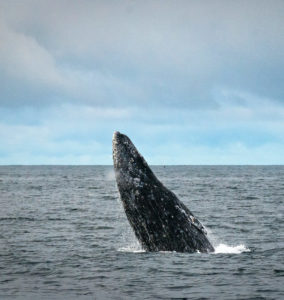
What kind of whales are watchable?
The most common whales watched from the Washington and Oregon coasts are Pacific gray whales. However, there are several other species of cetaceans swimming around including bottlenose dolphins, humpback whales, orcas, and even blue whales!
When can whales be watched?
There are a couple of times in the year when you might catch some whales as they pass the coast moving to and fro between their winter and summer spots. From mid-December to mid-January, an estimated 20,000 gray whales will swim south down the coast from their Alaskan feeding grounds to the warm winter waters of Baja California. The return trip happens April to June.
Why do they migrate, and where are they going?
A decrease in sunlight, less food, and a dip in water temperature in the Arctic all indicate to the whales that it’s time to travel. This is when they head south to luxuriate in the warm waters off the coast of Mexico where they mate and give birth before heading north again. Some whales like to stay put though – about 200 gray whales remain in coastal waters every year. In the summer and fall, it is possible to see these year-round residents feeding closer to shore.
image: “Gray Whale Breaching” by ericneitzel is licensed under CC BY-NC-ND 2.0.
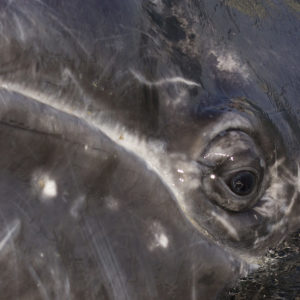
What are we looking for?
Here are some things to watch out for that will point you toward the location of nearby whales:
Look for the blow, or spout, which shoots nearly 12 feet high! If gray whales have been underwater for 5 minutes or more, they usually blow 5 times when they surface to replenish their oxygen supply.
An eye-catching behavior you might see is when a whale launches itself out of the water and splashes back down, this is called breaching. A whale breaching is one of the most exciting moments in whale watching.
Curious whales are often seen lifting their heads above the surface of the water to take a look around, this is called “spyhopping.”
Another conspicuous sign is when a whale lifts its tail flukes out of the water it is called fluking. This helps propel the whale downward at a steep angle to reach food. Classic photo op!
image: “Extremely Close Wild Gray Whale Head (Magdalena Bay, MX)” by Charlie Stinchcomb is licensed under CC BY 2.0.
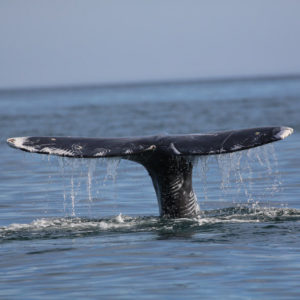
Gray Whale Facts
- Gray Whales have the longest migration of any mammal on Earth
- They are only found in the Pacific Ocean
- Gray whales are baleen whales and eat by filter-feeding – opening their mouth to take in water then pushing the water back out through their baleen while their food remains in their mouth
- Baby gray whales are called calves and weigh about 2,000 pounds when they are born
- Calves stay with their mothers for 8 months or so and can be seen as part of the northbound migration in the spring.
- White patches on the skin of gray whales are actually colonies of barnacles attached to the whale
- Gray whales generally come to the surface to breathe every 20 seconds when swimming and every 3-5 minutes when feeding – but if they are frightened, they can stay down for 30 minutes, hiding on the bottom or traveling great distances
- Gray whales have an average lifespan of 50 years
image: “Gray Whales Baja Jan (35)” by pamswatercolors is marked with Public Domain Mark 1.0
Join us for whale watching season!
We’ve got 2 hotels on the Oregon coast, close to the action. Ashore Hotel is located in Seaside, Oregon, just one block from the beach and a short drive to whale watching hot spots a little further south on the coast. Bowline Hotel in Astoria, Oregon is perched at the mouth of the Columbia River and very close to Fort Stevens State Park, a favorite whale watching location.
On the Long Beach Peninsula in Washington, whale fans are welcome at Adrift Hotel + Spa, Boardwalk Cottages, Inn at Discovery Coast, and Shelburne Hotel. Long Beach Peninsula is home to the very popular whale watching destination at North Head Lighthouse in Cape Disappointment State Park.
Whale Watching Resources
For more information on where to watch and how to plan your adventure, have a look at these resources for where to go, more tips on how to spot the whales, and more fun facts to share.
Long Beach Peninsula Whale Watch Guide
Oregon State Parks – Things to do: Whale Watching
Oregon State University – Whale Watching Guide
The Marine Mammal Center – Gray Whale Info Sheet
Oregon State Parks streams to their YouTube channel at the peak of the migrations and have lots of archived footage, too.
Get out there and good luck!
Our Places
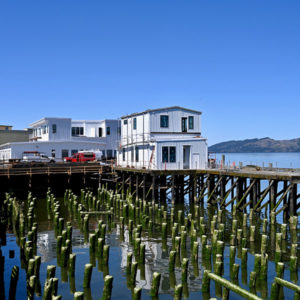
Bowline Hotel
Astoria, OR

Pickled Fish Restaurant
Long Beach, WA

Boardwalk Cottages
Long Beach, WA

Ashore Hotel
Seaside, OR

Shelburne Hotel
Seaview, WA
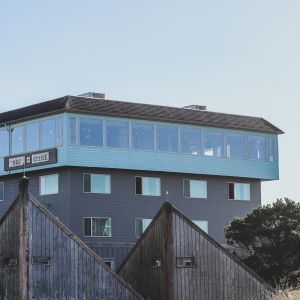
Adrift Hotel + Spa
Long Beach, WA
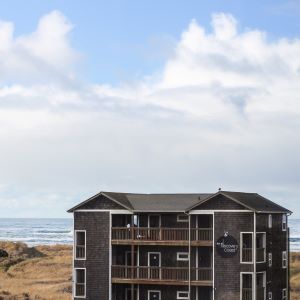
Inn at Discovery Coast
Long Beach, WA

Adrift Distillers
Long Beach, WA

